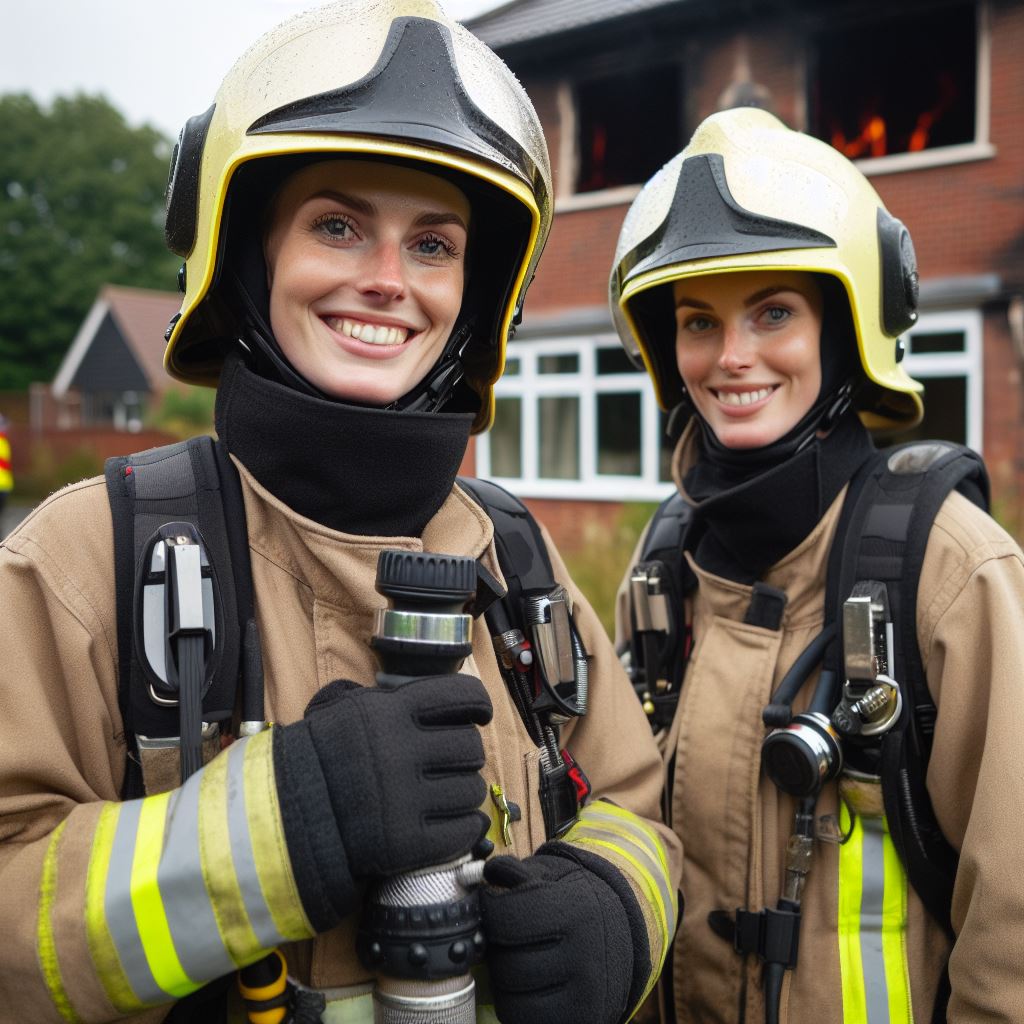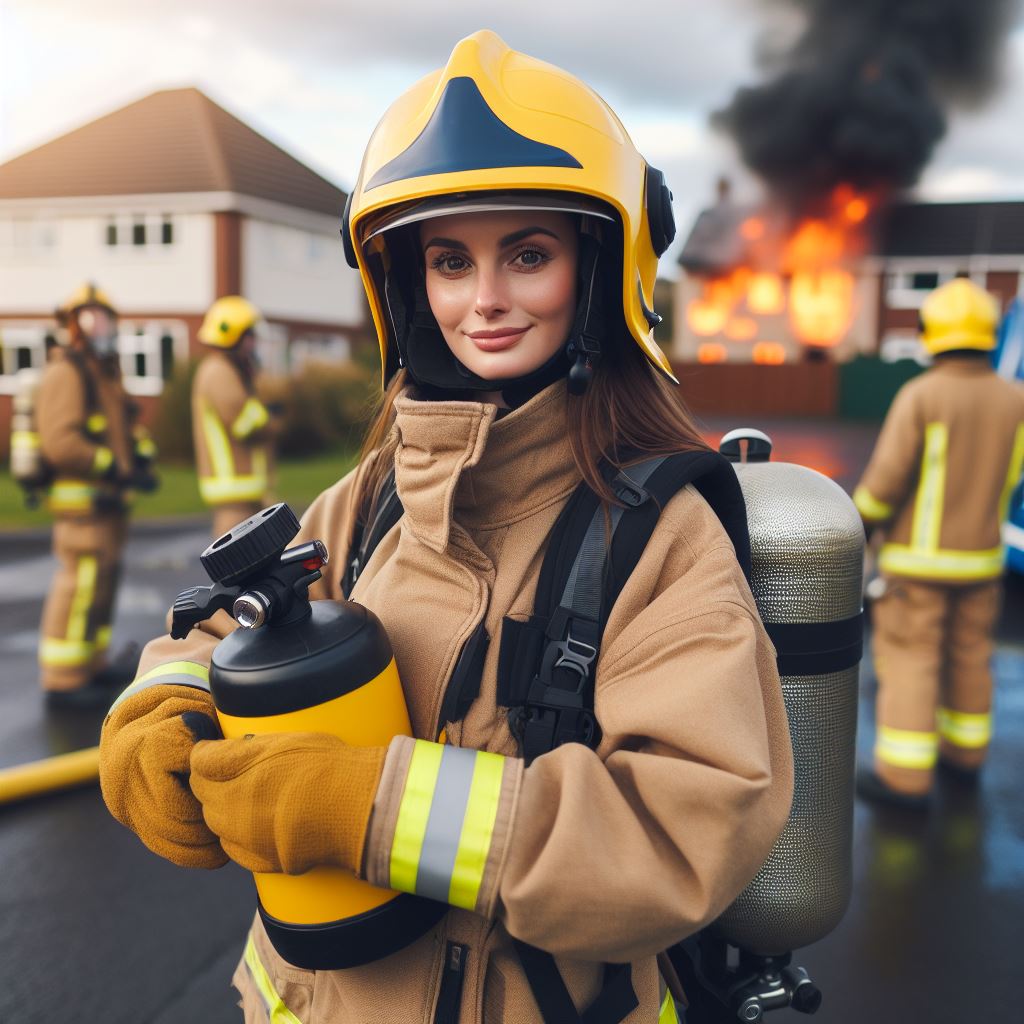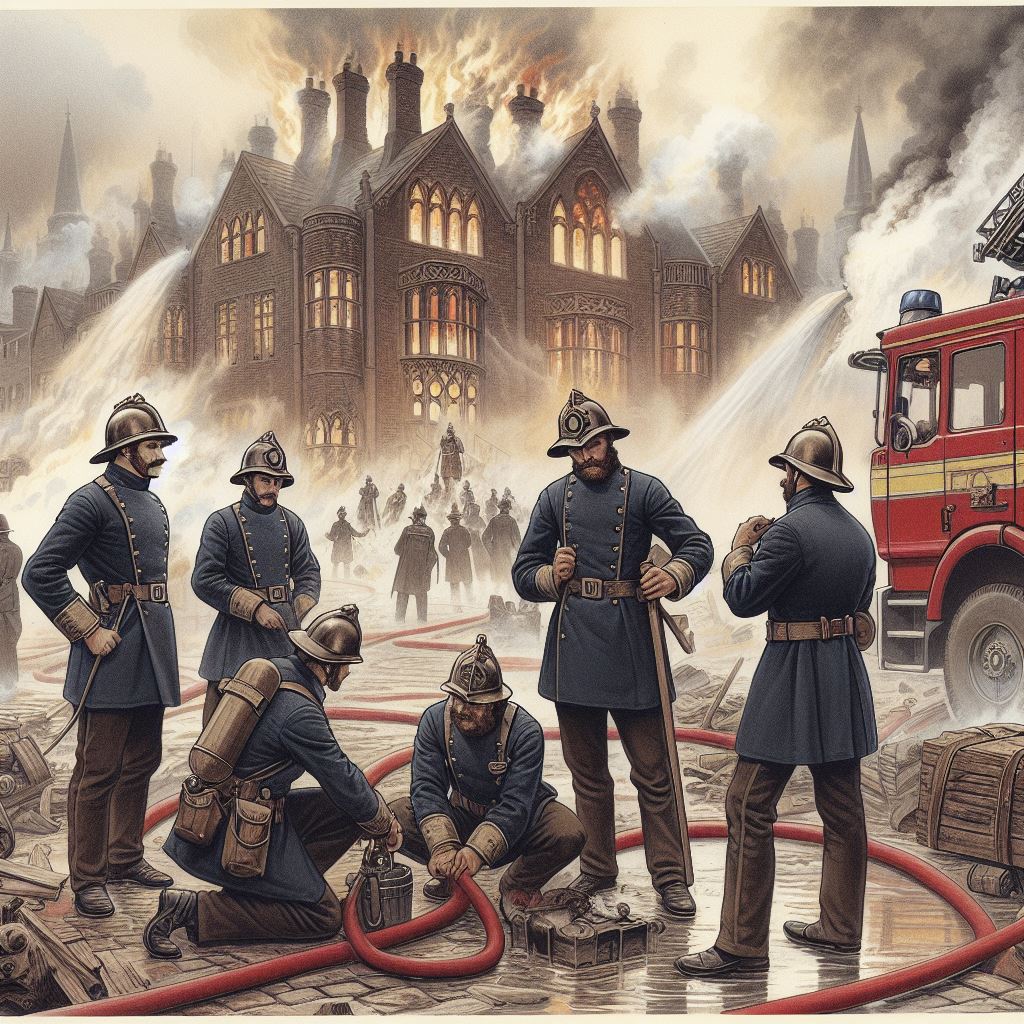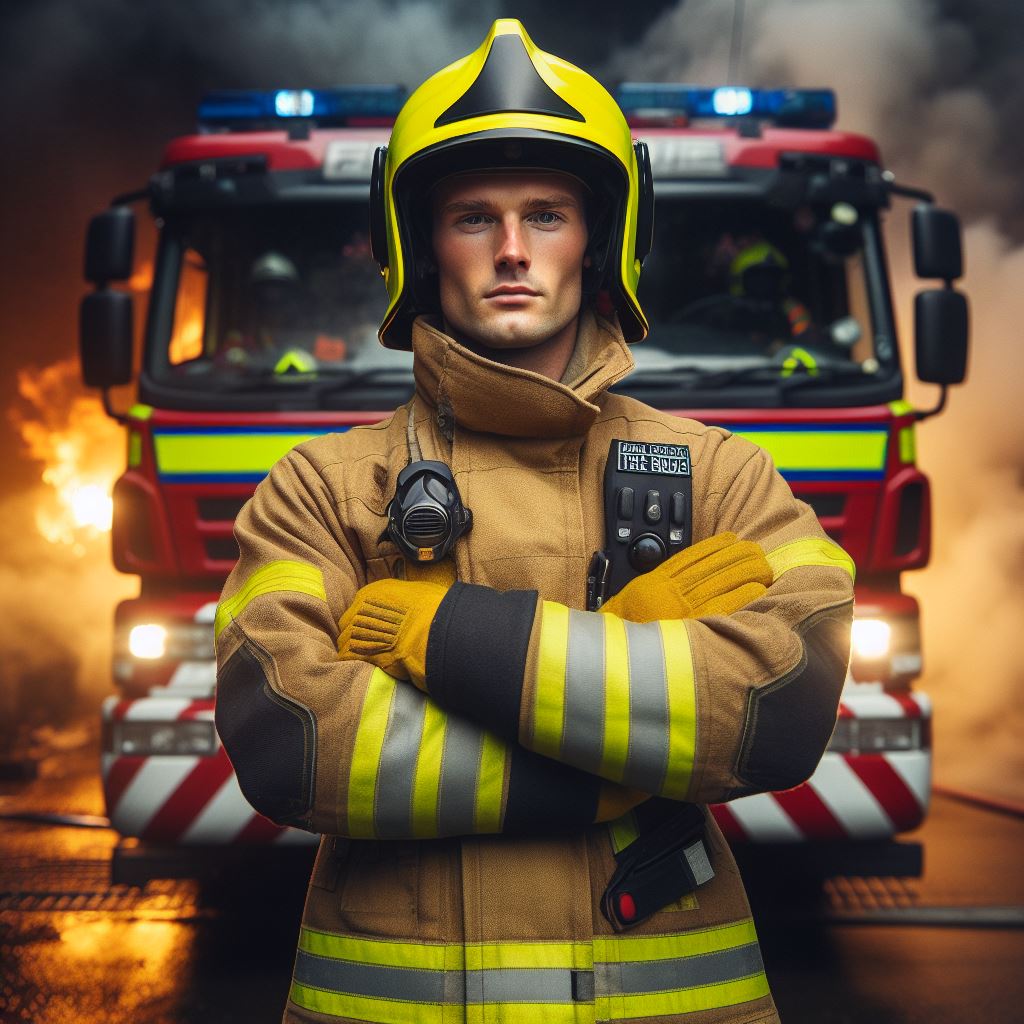Introduction
Firefighting is a dangerous and heroic profession. UK firefighters have specialized gear to protect themselves while saving lives.
This blog post will explore the essential firefighting gear worn by UK firefighters.
Firefighters in the UK wear a variety of gear and equipment to ensure their safety during operations.
The most important piece of gear is the firefighter’s suit, also known as personal protective equipment (PPE).
The suit is made of fire-resistant materials and consists of a helmet, jacket, pants, boots, and gloves.
The helmet is designed to protect the firefighter’s head from falling debris and extreme temperatures.
The jacket and pants are insulated with multiple layers to provide heat resistance and thermal protection.
These layers also act as a barrier against chemical splashes, water, and other hazardous materials.
The firefighter’s boots are made of heat-resistant materials and have steel toecaps to protect them from falling objects.
The gloves are specifically designed to provide dexterity and grip, allowing the firefighter to handle various tools and equipment.
Another crucial piece of gear is the self-contained breathing apparatus (SCBA), which supplies clean air to firefighters in toxic environments.
The SCBA includes a mask, air tank, pressure gauge, and regulator to ensure a continuous supply of breathable air.
In addition to the PPE and SCBA, firefighters also wear other equipment like fire-resistant hoods, goggles, and ear protection.
These accessories provide additional protection against heat, smoke, and loud noises during firefighting operations.
In short, UK firefighters wear specialized gear to protect themselves from the dangers they face while saving lives.
Personalized UK Career Consulting
Receive tailored career guidance designed just for you. Get actionable steps and expert support to boost your career in 1-3 days. Take control of your career now.
Get StartedProtective Clothing
Fire resistant Jacket
When it comes to firefighting, having the right gear is crucial for the safety and effectiveness of UK firefighters.
One of the most important components of their gear is the protective clothing they wear.
This clothing is specially designed to protect them from the hazards they may face in the line of duty.
The jacket offers insulation and protection from flames and extreme temperatures
The fire-resistant jacket that UK firefighters wear is made of durable materials that can withstand the harsh conditions they often encounter.
The jacket not only provides insulation but also offers protection from flames and extreme temperatures.
This is essential to prevent any injuries that could be caused by fire-related incidents.
It is designed to withstand heat, water, and physical impact
Additionally, the fire-resistant jacket is designed to withstand not only heat but also water and physical impact.
Firefighters often have to work in wet conditions or be exposed to high-pressure water streams, so having clothing that can resist water is crucial.
The jacket also needs to be able to withstand physical impact, as firefighters may encounter falling debris or other objects that could potentially harm them.
The clothing also includes fire-resistant trousers and a helmet
Alongside the fire-resistant jacket, UK firefighters also wear fire-resistant trousers.
These trousers provide additional protection to their lower body, ensuring that they are shielded from the hazards of fire and extreme heat.
The helmet is another essential part of their protective gear, as it protects their head from falling objects or potential head injuries.
Reflective strips enhance visibility in low-light situations
- Visibility is vital for firefighters, especially in low-light situations.
- To enhance visibility and ensure they can be easily spotted, the protective clothing includes reflective strips.
- These strips reflect light, making firefighters more visible to their colleagues and anyone else in the vicinity.
- This is crucial for coordination and safety during firefighting operations.
In summary, UK firefighters wear a comprehensive set of protective clothing that includes a fire-resistant jacket, trousers, helmet, and reflective strips.
These garments are designed to withstand heat, water, and physical impact, providing firefighters with the necessary protection to carry out their duties safely and effectively.
Your Dream Job Starts with a Perfect CV
Get a tailored CV and cover letter that captures your unique strengths and stands out in your industry. Let us help you make an unforgettable first impression.
Get StartedThe gear not only shields them from flames and extreme temperatures but also enhances their visibility in potentially dangerous situations.
With the right gear, UK firefighters can confidently face the challenges they encounter and protect both themselves and others from harm.
Read: A Day in the Life of a UK Firefighter
Breathing Apparatus
When it comes to fighting fires, protecting oneself from the dangers of smoke and toxic gases is crucial.
That’s where the breathing apparatus comes in.
Firefighters use self-contained breathing apparatus (SCBA) to breathe in hazardous environments
- Firefighters rely on self-contained breathing apparatus (SCBA) to safely breathe in hazardous environments.
- This essential gear ensures their respiratory system is protected while they battle flames and save lives.
SCBA consists of a mask, air cylinder, and regulator
- The SCBA consists of several key components, including a mask, air cylinder, and regulator.
- The mask is designed to provide a secure and airtight seal around the firefighter’s face, preventing any smoke or toxic fumes from entering the respiratory system.
It provides a constant flow of breathable air and protects against toxic gases, smoke, and heat
The air cylinder, which is typically made of lightweight materials such as carbon fiber, contains compressed air or oxygen.
This cylinder provides a constant flow of breathable air to the firefighter, enabling them to work efficiently in an environment where the air quality may be compromised.
The regulator is responsible for controlling the flow of air from the cylinder to the mask. It ensures a steady supply of air, maintaining a safe level of oxygen for the firefighter.
Additionally, it allows the firefighter to adjust the airflow based on their needs and the intensity of the fire.
One of the primary functions of the SCBA is to protect firefighters from exposure to hazardous gases, smoke, and heat.
In a fire scenario, the air can quickly become toxic, making it impossible to breathe without proper protection.
The SCBA filters out harmful substances, providing clean and breathable air for the firefighter to work in.
Designed to be lightweight and comfortable for extended use
- Furthermore, the SCBA is designed with the firefighter’s comfort and usability in mind.
- It is created to be lightweight, allowing firefighters to move freely and swiftly in emergency situations.
- The equipment also includes adjustable straps and padding for a snug and comfortable fit, reducing fatigue during extended operations.
- Firefighters undergo rigorous training to become familiar with the proper use of SCBA and to ensure their safety when operating in hazardous environments.
- They learn how to check the equipment for any damage or malfunctions before each use and how to handle emergency situations.
In general, breathing apparatus, specifically self-contained breathing apparatus (SCBA), plays a vital role in protecting firefighters from the dangers of smoke, toxic gases, and heat.
This essential gear enables them to work safely and effectively in hazardous environments, ensuring they can continue their life-saving work with confidence.
Optimize Your LinkedIn for Success
Boost your LinkedIn profile with a professional bio, keyword-rich headline, and strategic recommendations that attract recruiters. Stand out from the crowd and get noticed.
Optimize NowRead: Specialist Roles within UK Police Departments
Footwear and Gloves
Footwear and gloves play a crucial role in ensuring the safety and effectiveness of firefighters during their challenging tasks.
Let’s take a closer look at the specific gear they wear for their feet and hands.
Heat-Resistant Boots
Firefighters wear specially designed boots that are heat-resistant and feature high traction soles.
These boots are essential to protect their feet from burns and injuries caused by sharp objects on the ground.
The heat-resistant property of the boots is crucial because firefighters often encounter intense heat and flames while battling fires.
These boots are typically made of durable materials such as leather or rubber, which can withstand high temperatures.
Additionally, the high traction soles provide firefighters with stability and grip on various surfaces, including uneven terrain and slippery floors.
This feature is essential to prevent slips and falls, ensuring their safety while maneuvering through hazardous environments.
Fire-Resistant Gloves
- Firefighters wear gloves made of fire-resistant materials to provide hand protection from heat, flames, and other hazards encountered during firefighting operations.
- The gloves are designed to offer a balance between protection and dexterity, allowing firefighters to handle tools and equipment effectively.
- Firefighters frequently need to use their hands to operate firefighting tools, handle hoses, and perform precision tasks, making dexterity crucial in their line of work.
- The fire-resistant material used in these gloves provides a barrier against high temperatures, preventing burns and injuries to the hands.
- It also offers protection from direct contact with flames, reducing the risk of heat-related injuries.
- Moreover, these gloves are often reinforced with additional padding or thermal insulation in critical areas, such as the palms and fingers.
- This extra protection ensures enhanced durability and minimizes the risk of injuries, especially when handling sharp objects or heavy equipment.
- Firefighters also wear gloves that provide protection against other hazards they may encounter, including chemical substances and sharp debris.
- These gloves are essential to minimize the risk of cuts, punctures, or exposure to harmful materials during emergency situations
Basically, Footwear and gloves are vital components of a firefighter’s personal protective equipment (PPE).
The heat-resistant boots with high traction soles protect their feet from burns and injuries, while the fire-resistant gloves offer hand protection and dexterity for effective firefighting operations.
Investing in high-quality footwear and gloves empowers firefighters, ensuring they confidently confront challenges with essential gear for safety and efficient duty execution.
Read: UK Police and Public Relations: A Study

Personal Protective Equipment (PPE)
Firefighters wear personal protective equipment (PPE) to protect their bodies from various hazards.
This gear includes fire-resistant hoods, goggles, and face shields, which shield the face from debris and heat.
In addition, firefighters may also wear ear protection to preserve their hearing in loud and chaotic environments.
PPE is essential for minimizing injuries and maximizing safety.
PPE includes additional gear to protect the body from various hazards
Personal protective equipment (PPE) is crucial for firefighters as it provides them with the necessary protection against various hazards that they face while on duty.
It includes additional gear that is specifically designed to protect their bodies from the dangers associated with firefighting.
Fire-resistant hoods, goggles, and face shields to shield the face from debris and heat
One important component of PPE is the fire-resistant hood.
This hood is made from a special fabric that can withstand high temperatures and prevents the firefighter’s head and neck from being exposed to heat and flames.
It plays a vital role in protecting these sensitive areas from burns and reducing the risk of injury.
Goggles are another essential piece of PPE that firefighters wear. This protective eyewear shields their eyes from debris, smoke, and intense heat.
Goggles provide clear vision, enabling firefighters to effectively navigate through hazardous environments without compromising their sight or safety.
Face shields are also a crucial part of the firefighter’s PPE. These shields act as a barrier, protecting the entire face from potential impacts and burns.
They not only shield the face from debris but also help prevent injuries caused by heat and intense radiation.
Ear protection to preserve hearing in loud and chaotic environments
To ensure their safety and well-being, firefighters may also wear ear protection. This helps protect their hearing from the loud noises typically associated with firefighting.
In chaotic and intense fire situations, the noise levels can reach extremely high levels, potentially causing long-term damage to their ears.
Ear protection, such as earmuffs or earplugs, is worn to minimize the risk of hearing loss.
PPE is essential for minimizing injuries and maximizing safety
- Personal protective equipment is an essential part of a firefighter’s gear.
- It is designed to minimize the risk of injury and provide firefighters with optimal protection in hazardous situations.
- By wearing PPE, firefighters can focus on their duties without compromising their safety.
In review, personal protective equipment (PPE) plays a critical role in ensuring the safety of UK firefighters. PPE includes gear such as fire-resistant hoods, goggles, face shields, and ear protection.
These items provide protection against various hazards, including heat, debris, and loud noises.
By wearing PPE, firefighters can perform their duties with confidence, knowing that they have taken the necessary precautions to safeguard their well-being.
Read: Women in UK Policing: Changing Dynamics
Tools and Equipment
Firefighters rely on a range of essential tools and equipment to effectively combat fires and perform their duties.
These tools are vital for their safety and the successful execution of their tasks. Here are some of the tools commonly used by UK firefighters:
Firefighters carry essential tools such as an axe, pike pole, and hose line
Axes are utilized to breach walls and doors, allowing access to buildings engulfed in flames
The axe is a versatile tool that is instrumental in various firefighting scenarios.
Its primary purpose is to breach through walls, doors, and other barriers hindering entry into a burning building.
By creating openings, firefighters can gain access to the interior and assess the situation more effectively.
Pike poles play a crucial role in both ventilation and searching for hidden fires within structures
Pike poles, also known as pike poles or hook poles, are another indispensable tool carried by firefighters.
These long poles with a pointed hook at one end are used for multiple purposes.
One key application is ventilation, where pike poles are used to break windows or create openings in roofs.
This helps release smoke, heat, and toxic gases from the building, improving visibility and increasing safety for the firefighters inside.
Additionally, pike poles are used for searching areas where hidden fires may be present, such as ceilings or concealed spaces.
The hose line is the primary tool for extinguishing flames and gaining control over the fire
The hose line is undoubtedly one of the most critical pieces of equipment for firefighters.
It allows them to deliver water or extinguishing agents directly to the fire, enabling them to extinguish flames effectively.
The hose line is often attached to a water source, such as a hydrant or a water pump on the fire engine.
Firefighters skillfully maneuver the hose to control and direct the water flow, targeting the base of the fire for maximum impact.
The hose line’s length and diameter vary, depending on the specific requirements of different firefighting operations.
Firefighters also employ specialized equipment for specific situations
- Depending on the situation, firefighters may also utilize additional specialized equipment.
- For instance, thermal imaging cameras can be used to locate hidden heat sources and trapped individuals within a structure.
- These cameras detect infrared radiation, enabling firefighters to navigate through smoke and darkness more effectively.
- Self-contained breathing apparatus (SCBA) ensures firefighters breathe clean air in hazardous, smoke or chemical-contaminated environments.
Ultimately, the tools and equipment carried by UK firefighters play a vital role in their ability to respond to emergencies and save lives.
Each tool has a specific purpose and contributes to the overall effectiveness of firefighting operations.
By utilizing these tools skillfully and with expertise, firefighters can successfully carry out their duties in the face of blazing fires and hazardous conditions.
Conclusion
In the perilous realm of firefighting, the gear donned by UK firefighters isn’t just apparel; it’s a meticulously crafted shield, an arsenal designed for optimum protection and efficiency.
Each component of the gear serves a distinct purpose, meticulously engineered to safeguard firefighters as they navigate the unpredictable landscapes of emergencies.
From the robust helmet that shields their heads to the flame-resistant suits that envelop their bodies, every element is a vital layer of defense.
In the tapestry of emergency response, the gear is the silent partner, an active participant in the heroic narrative woven by firefighters.
As they navigate through the chaos, this gear stands as a testament to their commitment, a tangible expression of the courage that defines their service.
In closing, the synergy between the dedication of UK firefighters and their specialized gear is the linchpin in the chain of community safety.
It’s a duty-forged partnership, where each piece of equipment symbolizes not just protection but an unwavering promise to communities.
[E-Book for Sale]
500 Cutting-Edge Tech Startup Ideas for 2024 & 2025: Innovate, Create, Dominate
$19.99 • 500 Tech Startup Ideas • 62 pages
You will get inspired with 500 innovative tech startup ideas for 2024 and 2025, complete with concise descriptions to help you kickstart your entrepreneurial journey in AI, Blockchain, IoT, Fintech, and AR/VR.




